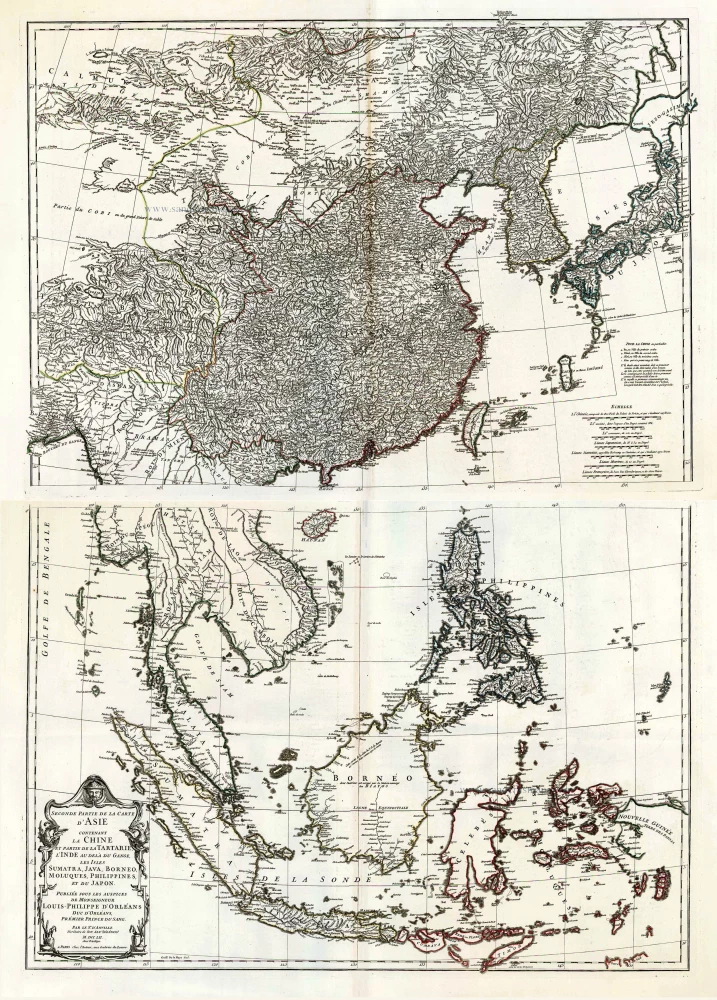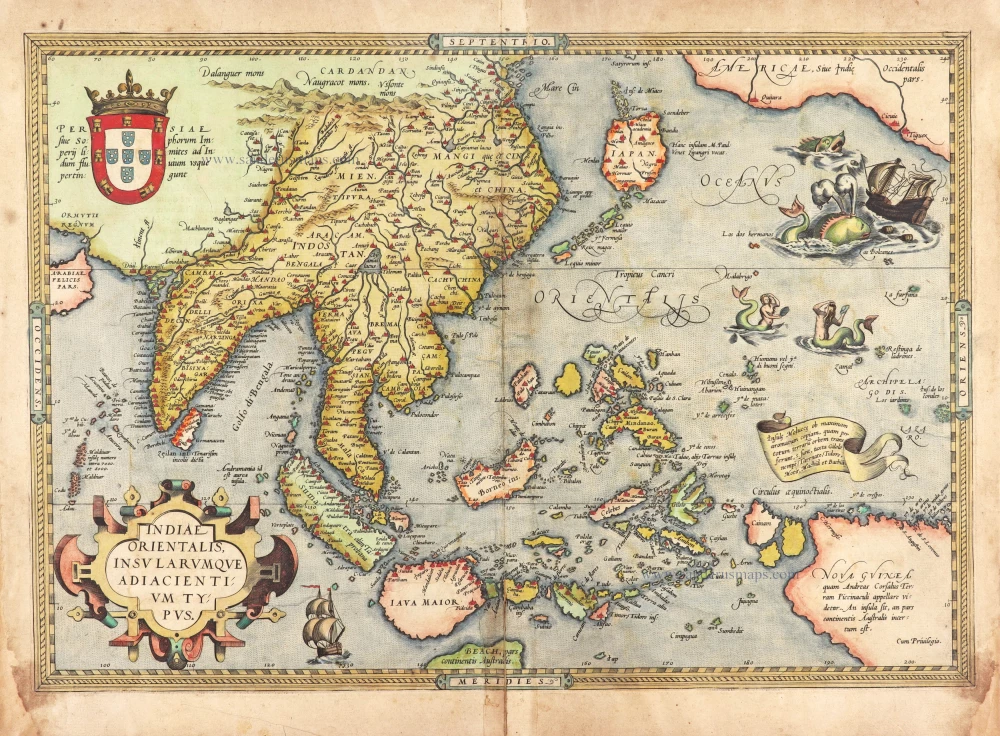The most accurate and one of the most elegant 17th c. maps of the East Indies
Southeast Asia by Janssonius, Johannes c. 1630-1650
"The Hondius-Jansson publication included a new map of Southeast Asia and the East Indian archipelago by Jan Jansson entitled 'India Orientalis Nova Descriptio'. The map was the most accurate and one of the most elegant seventeenth-century maps of the East Indian Islands. It included one of the first inferences to the discoveries made on the northwestern coast of Australia in 1606 by William Jansz on the ship Duyfken. On the south coast of New Guinea, the name 'Dufkens Eylant' appears, thereby immortalising the name of the ship by which Australia had been discovered in 1606; however, the map only reaches ten degrees south latitude and does not show any part of the Australian mainland. The False Cape (Valschen Caep) and the Torres Strait or embayment would be hidden behind the decorative scale bar if mapped. Schilder believes that Jansson's map was of the greatest importance until the copy of the original 'Duyfken' map and the 1622 manuscript map of the Pacific by Hessel Gerritz, Blaeu's predecessor in the post of Official Hydrographer to the VOC, were found. William Blaeu must have been privy to these discoveries from his official position at the Dutch East India Company. Still, he did not publish his classic regional map, 'India Quae Orientalis Dicitur et Insulae Adiacentes, ' showing part of the Australian mainland, until 1635." (Parry, p.105)
The Janssonius Family
Joannes Janssonius (Arnhem, 1588-1664), son of the Arnhem publisher Jan Janssen, married Elisabeth Hondius, daughter of Jodocus Hondius, in Amsterdam in 1612. After his marriage, he settled down in this town as a bookseller and publisher of cartographic material. In 1618, he established himself in Amsterdam next door to Blaeu’s bookshop. He entered into serious competition with Willem Jansz. Blaeu when copying Blaeu’s Licht der Zeevaert after the expiration of the privilege in 1620. His activities concerned the publication of atlases, books, single maps, and an extensive book trade with branches in Frankfurt, Danzig, Stockholm, Copenhagen, Berlin, Koningsbergen, Geneva, and Lyon. In 1631, he began publishing atlases together with Henricus Hondius.
In the early 1640s, Henricus Hondius left the atlas publishing business to Janssonius. Competition with Joan Blaeu, Willem’s son and successor, in atlas production, prompted Janssonius to enlarge his Atlas Novus finally into a work of six volumes, into which a sea atlas and an atlas of the Old World were inserted. Other atlases published by Janssonius are Mercator’s Atlas Minor, Hornius’s historical atlas (1652), the townbooks in eight volumes (1657), Cellarius’s Atlas Coelestis and several sea atlases and pilot guides.
After the death of Joannes Janssonius, the shop and publishing firm were continued by the heirs under the direction of Johannes van Waesbergen (c. 1616-1681), son-in-law of Joannes Janssonius. Van Waesbergen added Janssonius's name to his own.
In 1676, Joannes Janssonius’s heirs sold by auction “all the remaining Atlases in Latin, French, High and Low German, as well as the Stedeboecken in Latin, in 8 volumes, bound and unbound, maps, plates belonging to the Atlas and Stedeboecken.” The copperplates from Janssonius’s atlases were afterwards sold to Schenk and Valck.
Indiae Orientalis Nova Descriptio.
Currently not available
Item Number: 30855 Authenticity Guarantee
Category: Antique maps > Asia > Southeast Asia
Southeast Asia by Janssonius, Johannes.
Title: Indiae Orientalis Nova Descriptio.
Amstelodami Ioannes Ianßonius excudebat.
Date of the first edition: 1630.
Date of this map: c. 1630-1650.
Copper engraving, printed on heavy paper.
Image size: 390 x 503mm (15.35 x 19.8 inches).
Sheet size: 505 x 690mm (19.88 x 27.17 inches).
Verso: Blank.
Condition: Original coloured, side margins extended; age-toned.
Condition Rating: A.
Separate publication - from a French Composite Atlas, c. 1630-1650.
"The Hondius-Jansson publication included a new map of Southeast Asia and the East Indian archipelago by Jan Jansson entitled 'India Orientalis Nova Descriptio'. The map was the most accurate and one of the most elegant seventeenth-century maps of the East Indian Islands. It included one of the first inferences to the discoveries made on the northwestern coast of Australia in 1606 by William Jansz on the ship Duyfken. On the south coast of New Guinea, the name 'Dufkens Eylant' appears, thereby immortalising the name of the ship by which Australia had been discovered in 1606; however, the map only reaches ten degrees south latitude and does not show any part of the Australian mainland. The False Cape (Valschen Caep) and the Torres Strait or embayment would be hidden behind the decorative scale bar if mapped. Schilder believes that Jansson's map was of the greatest importance until the copy of the original 'Duyfken' map and the 1622 manuscript map of the Pacific by Hessel Gerritz, Blaeu's predecessor in the post of Official Hydrographer to the VOC, were found. William Blaeu must have been privy to these discoveries from his official position at the Dutch East India Company. Still, he did not publish his classic regional map, 'India Quae Orientalis Dicitur et Insulae Adiacentes, ' showing part of the Australian mainland, until 1635." (Parry, p.105)
The Janssonius Family
Joannes Janssonius (Arnhem, 1588-1664), son of the Arnhem publisher Jan Janssen, married Elisabeth Hondius, daughter of Jodocus Hondius, in Amsterdam in 1612. After his marriage, he settled down in this town as a bookseller and publisher of cartographic material. In 1618, he established himself in Amsterdam next door to Blaeu’s bookshop. He entered into serious competition with Willem Jansz. Blaeu when copying Blaeu’s Licht der Zeevaert after the expiration of the privilege in 1620. His activities concerned the publication of atlases, books, single maps, and an extensive book trade with branches in Frankfurt, Danzig, Stockholm, Copenhagen, Berlin, Koningsbergen, Geneva, and Lyon. In 1631, he began publishing atlases together with Henricus Hondius.
In the early 1640s, Henricus Hondius left the atlas publishing business to Janssonius. Competition with Joan Blaeu, Willem’s son and successor, in atlas production, prompted Janssonius to enlarge his Atlas Novus finally into a work of six volumes, into which a sea atlas and an atlas of the Old World were inserted. Other atlases published by Janssonius are Mercator’s Atlas Minor, Hornius’s historical atlas (1652), the townbooks in eight volumes (1657), Cellarius’s Atlas Coelestis and several sea atlases and pilot guides.
After the death of Joannes Janssonius, the shop and publishing firm were continued by the heirs under the direction of Johannes van Waesbergen (c. 1616-1681), son-in-law of Joannes Janssonius. Van Waesbergen added Janssonius's name to his own.
In 1676, Joannes Janssonius’s heirs sold by auction “all the remaining Atlases in Latin, French, High and Low German, as well as the Stedeboecken in Latin, in 8 volumes, bound and unbound, maps, plates belonging to the Atlas and Stedeboecken.” The copperplates from Janssonius’s atlases were afterwards sold to Schenk and Valck.



























